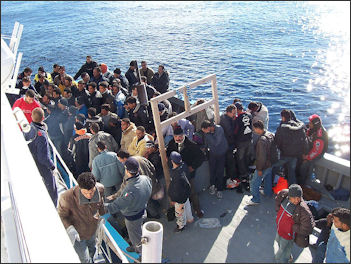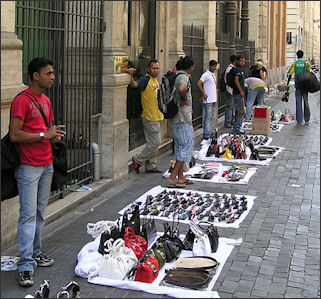MINORITIES IN THE DEVELOPING WORLD

A Muslim Hui family in China There are an estimated 370 million indigenous people in the world today. In September 2007, the United Nations adopted a nonbinding declaration upholding the human, land and resource rights of the world’s indigenous people, despite objections from Australia, the United States, Canada and New Zealand. The declaration, which came after 20 years of debate, was passed by a vote of 143-4 with 11 abstentions, including Russia and Columbia.
The declaration recognizes the right if of indigenous peoples to self-determination and sets global rights standards for them. It states that native peoples have the right “to the recognition, observance and enforcement of treaties” concluded with states and their successors.
Australia, the United States , Canada and New Zealand objected to provisions on self-determination, land and resources rights and giving indigenous peoples a right of veto over national legislation and state management of resources.
European and American visitors to developing countries generally fall into six categories: 1) diplomats and journalists; 2) development workers; 3) Christian missionaries; 4) tourists; 5) retired European residents; and 6) religious seekers.
Immigration and the Developing World
As of 2008, there were 200 million migrants around the world, with 70.6 million in Europe, 45.1 million in North America and 25.3 million in Asia. Many make dangerous journeys and border crossings to get where they are going. Most of today’s migrants come from Asia. By 2030 40 percent of the global work force will come from China or India.
According to Geneva-based International Organization for Migration the rich countries need more migrant workers not less.
Worldwide migrant workers sent home $167 billion in 2008 up from $85 billion in 2000. Studies indicate that about 85 percent of this money is spent on paying daily bills rather than put in savings, which could help boost the economies of their home countries by providing more money for investment.
Hostility in Rich Countries Towards Immigrants

Boat People in SicilyIn 2011The Economist reported: “This is not a good time to be foreign. Anti-immigrant parties are gaining ground in Europe. Britain has been fretting this week over lapses in its border controls (see article). In America Barack Obama has failed to deliver the immigration reform he promised (see article), and Republican presidential candidates would rather electrify the border fence with Mexico than educate the children of illegal aliens. America educates foreign scientists in its universities and then expels them, a policy the mayor of New York calls “national suicide”. [Source: The Economist, November 19, 2011]
This illiberal turn in attitudes to migration is no surprise. It is the result of cyclical economic gloom combined with a secular rise in pressure on rich countries’ borders. But governments now weighing up whether or not to try to slam the door should consider another factor: the growing economic importance of diasporas, and the contribution they can make to a country’s economic growth.
Such arguments are unlikely to make much headway against hostility towards immigrants in rich countries. Fury against foreigners is usually based on two (mutually incompatible) notions: that because so many migrants claim welfare they are a drain on the public purse; and that because they are prepared to work harder for less pay they will depress the wages of those at the bottom of the pile.
The first is usually not true (in Britain, for instance, immigrants claim benefits less than indigenous people do), and the second is hard to establish either way. Some studies do indeed suggest that competition from unskilled immigrants depresses the wages of unskilled locals. But others find this effect to be small or non-existent.
Nor is it possible to establish the impact of migration on overall growth. The sums are simply too difficult. Yet there are good reasons for believing that it is likely to be positive. Migrants tend to be hard-working and innovative. That spurs productivity and company formation. A recent study carried out by Duke University showed that, while immigrants make up an eighth of America’s population, they founded a quarter of the country’s technology and engineering firms. And, by linking the West with emerging markets, diasporas help rich countries to plug into fast-growing economies.
Immigrant Networks, A Spark in the World Economy

Street hawkers in Rome The Economist reported: “Diaspora networks”of Huguenots, Scots, Jews and many others — have always been a potent economic force, but the cheapness and ease of modern travel has made them larger and more numerous than ever before. There are now 215 million first-generation migrants around the world: that’s 3 percent of the world’s population. If they were a nation, it would be a little larger than Brazil. There are more Chinese people living outside China than there are French people in France. Some 22m Indians are scattered all over the globe. Small concentrations of ethnic and linguistic groups have always been found in surprising places — Lebanese in west Africa, Japanese in Brazil and Welsh in Patagonia, for instance — but they have been joined by newer ones, such as west Africans in southern China. [Source: The Economist, November 19, 2011]
These networks of kinship and language make it easier to do business across borders (see article). They speed the flow of information: a Chinese trader in Indonesia who spots a gap in the market for cheap umbrellas will alert his cousin in Shenzhen who knows someone who runs an umbrella factory. Kinship ties foster trust, so they can seal the deal and get the umbrellas to Jakarta before the rainy season ends. Trust matters, especially in emerging markets where the rule of law is weak. So does a knowledge of the local culture. That is why so much foreign direct investment in China still passes through the Chinese diaspora. And modern communications make these networks an even more powerful tool of business.
Diasporas also help spread ideas. Many of the emerging world’s brightest minds are educated at Western universities. An increasing number go home, taking with them both knowledge and contacts. Indian computer scientists in Bangalore bounce ideas constantly off their Indian friends in Silicon Valley. China’s technology industry is dominated by “sea turtles” (Chinese who have lived abroad and returned).
Diasporas spread money, too. Migrants into rich countries not only send cash to their families; they also help companies in their host country operate in their home country. A Harvard Business School study shows that American companies that employ lots of ethnic Chinese people find it much easier to set up in China without a joint venture with a local firm.
Rich countries are thus likely to benefit from looser immigration policy; and fears that poor countries will suffer as a result of a “brain drain” are overblown. The prospect of working abroad spurs more people to acquire valuable skills, and not all subsequently emigrate. Skilled migrants send money home, and they often return to set up new businesses. One study found that unless they lose more than 20 percent of their university graduates, the brain drain makes poor countries richer.

Boat people from Haiti Government as well as business gains from the spread of ideas through diasporas. Foreign-educated Indians, including the prime minister, Manmohan Singh (Oxford and Cambridge) and his sidekick Montek Ahluwalia (Oxford), played a big role in bringing economic reform to India in the early 1990s. Some 500,000 Chinese people have studied abroad and returned, mostly in the past decade; they dominate the think-tanks that advise the government, and are moving up the ranks of the Communist Party. Cheng Li of the Brookings Institution, an American think-tank, predicts that they will be 15-17 percent of its Central Committee next year, up from 6 percent in 2002. Few sea turtles call openly for democracy. But they have seen how it works in practice, and they know that many countries that practise it are richer, cleaner and more stable than China.
As for the old world, its desire to close its borders is understandable but dangerous. Migration brings youth to ageing countries, and allows ideas to circulate in millions of mobile minds. That is good both for those who arrive with suitcases and dreams and for those who should welcome them.
Remittances
Remittances (the wiring of money from one place to another) has become the principal source of foreign capital in the developing world. More money is wired from people in developing countries, working overseas, to family members in their home countries than these countries receive in foreign aid or foreign investment. [Source: Foreign Policy magazine]
Most of the remittance money arrives as a few hundred dollars wired every month, enough to boost a family from abject poverty to having enough to eat, buy things they need and possibly start a business. The money is particularly important in very poor countries and is generally spent on food and clothing, education, medicines and housing. Remittances are good on a personal and development level because the money goes directly to people who need it without inference from foreign governments, aid agencies and corrupt officials.

Somali Grocery store in the U.S. The amount of remittances sent to developing countries rose from $17.7 billion in 1980 to $30.6 billion in 1990 to $59 billion in 1995, roughly equal to foreign aid that year, to $80 billion in 2002 to $160 billion in 2004, double the foreign aid that year. The rise is attributable to the increase in the number of migrant workers working abroad, particularly in the United States, Europe and oil-exporting Persian Gulf states.
Some of the money is wired. Some is sent using Informal Value Transfer System set up by people in home countries and where the immigrants are working. Remittances are a manifestation of the global migration of labor and the relaxing of restrictions on the international movement of money encouraged by the IMF. Some forms of remittances have come under review because some money is believed to end up in the hands of terrorist networks such Al-Qaida.
Image Sources: Wikimedia Commons
Text Sources: New York Times, Washington Post, Los Angeles Times, Times of London, Yomiuri Shimbun, The Guardian, National Geographic, The New Yorker, Time, Newsweek, Reuters, AP, Lonely Planet Guides, Compton’s Encyclopedia and various books and other publications.
Last updated January 2012
